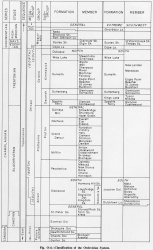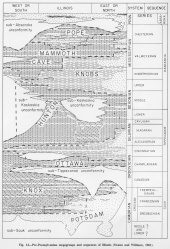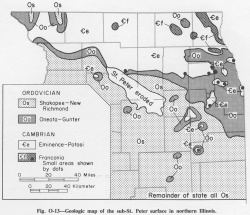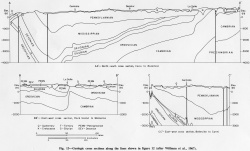Champlainian Series
Chronostratigraphy: Paleozoic Erathem >>Ordovician System >>Champlainian Series
Allostratigraphy: Tippecanoe Sequence
Primary source
Willman, H. B., Elwood Atherton, T. C. Buschbach, Charles Collinson, John C. Frye, M. E. Hopkins, Jerry A. Lineback, and Jack A. Simon, 1975, Handbook of Illinois Stratigraphy: Illinois State Geological Survey Bulletin 95, 261 p.
Contributing author(s)
H. B. Willman and T. C. Buschbach
Name
Original description
Champlainian Series (Emmons, 1842, p. 99-126; Schuchert and Barrell, 1914, p. 16, 25).
Derivation
Named for Lake Champlain, New York.
Other names
The name "Champlainian" has been used in Illinois since 1963 (Templeton and Willman). Before then, these strata were called Middle Ordovician or subdivided into the Chazyan and Mohawkian Series.
History/background
Type section
Type location
Type author(s)
Type status
Reference section
Reference location
Reference author(s)
Reference status
Stratigraphic relationships
The Champlainian Series unconformably overlies Canadian dolomite throughout Illinois and is unconformably overlain by Cincinnatian shales and limestone.
The Champlainian Series is subdivided into the Chazyan, Blackriveran, and Trentonian Stages (fig. O-4), which are based on the New York section (Kay, 1960). Although the classification in New York has been repeatedly modified, these stages have wide regional extent and their boundaries correspond to the major faunal and physical changes in the Champlainian of Illinois (Templeton and Willman, 1963). Different classifications developed in the outcrop areas in northern and southern Illinois, but many of the differences have been eliminated (fig. O-12).
The unconformity at the base of the Champlainian rocks is one of the major unconformities in Illinois. It separates the Sauk Sequence (below) from the Tippecanoe Sequence (above) (fig. 14). Throughout most of Illinois the sub-Tippecanoe unconformity cuts deeply into Canadian rocks and locally through both the Canadian and the Cambrian Trempealeauan into Franconian rocks (fig. O-13). The Sauk Sequence dips southward in the Illinois Basin at a low angle, slightly greater than that of the overlying Tippecanoe Sequence (fig. 13). In the northern Illinois outcrop area, the Sauk rocks show more local deformation than the overlying Tippecanoe strata. Throughout most of Illinois the sub-Tippecanoe unconformity represents the combined effects of unconformities that occur both above and below the Chazyan strata, and the relative significance of the two unconformities has not been evaluated. The St. Peter Sandstone, which overlies the sub-Tippecanoe unconformity in most of the state, rests on a very irregular erosional surface, in part the result of a karst topography developed on the underlying carbonate rocks. A thick accumulation of residual materials (Kress Member) occurs at the base of the St. Peter in some localities (Buschbach,1964).
An unconformity at the base of the Trentonian rocks is widespread and is accompanied by major changes in lithology and fauna, but it does not deeply truncate the underlying strata. The uppermost Blackriveran Quimbys Mill Formation is missing in some areas north of Illinois, but in Illinois only the upper part is eroded, and that only locally. The Blackriveran-Trentonian contact generally is a strongly pitted, iron-stained corrosion surface. The basal Trentonian Spechts Ferry Formation thins eastward and is absent in the eastern half of Illinois, where it probably never was deposited.
Minor unconformities also occur in Champlainian strata at the base of the Pecatonica Formation and the base of the Guttenberg Formation, both accompanied by concentrations of phosphate nodules and the local absence of several feet of the underlying formation.
Extent and thickness
The series ranges in thickness from 1700 feet in the south to 500 feet in the north.
Lithology
The Champlainian rocks are dominantly carbonates, mostly limestone in the south and dolomite in the north, but they include the St. Peter Sandstone at the base, except in the southwestern part of the state where dolomite and sandstone of the Chazyan Everton Formation underlies the St. Peter.
Core(s)
Photograph(s)
Contacts
Well log characteristics
Fossils
Age and correlation
Environments of deposition
Economic importance
Remarks
References
BUSCHBACH, T. C., 1964, Cambrian and Ordovician strata of northeastern Illinois: Illinois State Geological Survey Report of Investigations 218, 90 p.
EMMONS, EBENEZER, 1842, Geology of New York, Part 2, comprising the survey of the second geological district: Albany, 437 p.
KAY, MARSHALL, 1960, Classification of the Ordovician System in North America: 21st International Geological Congress, Copenhagen, 1960, Reports, part 7, p. 28-33.
SCHUCHERT, CHARLES, and JOSEPH BARRELL, 1914, Revised geologic time-table for North America: American Journal of Science, v. 38, p. 1-27.
TEMPLETON, J. S., and H. B. WILLMAN, 1963, Champlainian Series (Middle Ordovician) in Illinois: Illinois State Geological Survey Bulletin 89, 260 p.
ISGS Codes
| Stratigraphic Code | Geo Unit Designation |
|---|---|




